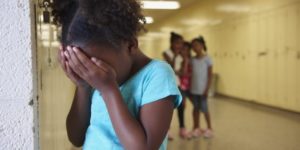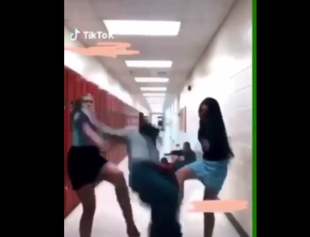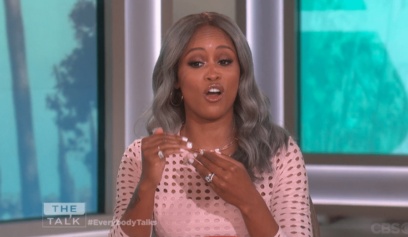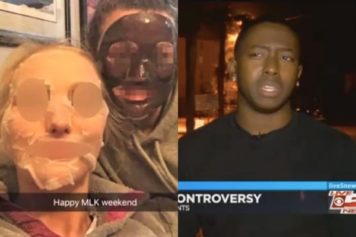
Bullying can leave its young victims with a reduced sense of self-worth. (Source: myblackmatters.com)
October is National Bullying Prevention Month. Bullying among and against Black youth poses a continual problem to our community as both victim and the aggressor. As reported last year, 8-year-old Jordan Jackson was told, “You need to go back to the cotton farm,” by a young white boy on a playground last year as Jordan and his younger sister waited for their parents at Spanish Lake Primary School in Geismar, Louisiana.
The racist outburst came after Jordan, asked a group to stop throwing mulch at him and his 4-year-old sister, J’Niaha. Jordan was subsequently pushed down multiple times and body slammed at least twice, suffering a broken arm and a concussion, which has evolved into post-concussion syndrome.
Recently a bullied student became violent in a Bronx, N.Y., school when Abe Cedeno, 18, reportedly stabbed two classmates he accused of bullying him. Cedeno — who killed Matthew McCree, 15, and wounded Ariane Laboy, 16 — claims he only wanted to scare the boys with his switchblade and did not intend to kill anyone, but snapped. Cedeno, who is bisexual, said he was the victim of anti-gay bullying, and classmates called him a f—-t and slammed him into hallway lockers. This incident is just another example of the consequences of bullying, the cycle of violence it creates, and the underlying complex social issues adults must confront and address to prevent and stop it.
More than 160,000 students across the country don’t go to school each day because they’re afraid of getting bullied, called names and beaten up. Although the issue has started to receive national attention, actual solutions are still hard to come by.
Bullying is defined as “unwanted, aggressive behavior among school-aged children that involves a real or perceived power imbalance. The behavior is repeated, or has the potential to be repeated, over time. Bullying includes actions such as making threats, spreading rumors, attacking someone physically or verbally, and excluding someone from a group on purpose.” Bullying takes various forms, as it can be physical, such as assault, intimidation or destruction of one’s property; verbal, including name-calling and threats, and psychological or relational, which could involve gossip, rumors or social exclusion. The bullying may occur in person or via technological means — cyberbullying — such as email, text messages and chat rooms. Typically, the victim has done nothing to precipitate the bullying, and has difficulty defending himself or herself. Kids who experience bullying suffer from compromised physical and mental health, depression and lessened self-worth.
“Bullying is endemic to American society. It is modeled daily as a strategy for dealing with differences by our president, politicians, and many others in positions of power. It has come to be associated with power, popularity, and status,” Huberta Jackson-Lowman, Ph.D., President of the Association of Black Psychologists, told Atlanta Black Star. Dr. Jackson-Lowman said research shows that bullying is often used by “popular kids” such as football players and fraternity members, and those who are less popular emulate such behavior to gain acceptance. “Since our media gives so much attention to those who use bullying as a strategy for managing their feelings and conflicts, it is complicit in reinforcing the use of bullying as a strategy for managing emotions,” she added. According to StopBullying.gov, a website of the U.S. Department of Health and Human Services, trends in media coverage of bullying can do harm by spreading misinformation. Pitfalls of media coverage of bullying include sensationalizing; overstating the problem or oversimplifying the issues surrounding a bullying incident; blaming or criminalizing bullies; using unqualified sources; implying bullying caused a suicide and failing to include prevention information.
Widespread and underreported, bullying is a problem in the Black and Latino communities. A 2014 study in the Journal of Child and Adolescent Psychiatric Nursing found that Black children have higher rates of bullying, and are more likely to be involved as a victim, aggressor or bystander than others. The federal government has reported that Black and Latino youth who are bullied suffer academically when compared to white children.
Children mirror adults, so to better understand what they are facing, look to the grownups and what they have refused to address themselves, suggests Dr. Jackson-Lowman. “The issues that Black youth and children bully each other about are those issues about which we as Black adults have unresolved and [conflicted]feelings and which are also viewed negatively or with great ambivalence by the larger society,” she said, noting matters including homosexuality, transgenderism, skin color, and hair texture.
“Within the Black community, what it means to be a man is deeply entangled with hegemonic Eurocentric definitions of masculinity,” Dr. Jackson-Lowman suggests, having implications for bullying. “For Black men who have been denied access to power, identification with violent, aggressive, and unemotional models of what it means to be a man may become a way of asserting their masculinity in a society that denies them positive avenues for expressing it,” Jackson-Lowman said.
There are solutions to the problem of bullying. For example, StopBullying.gov suggests that parents, school staff and others in the community have a role to play. They can discuss the issue, formulate anti-bullying strategies for the community and create a safe school environment for children. The Bully Project has developed tools and resources for students, teachers, parents and advocates, online workshops, and a toolkit for children with special needs.
What can the Black community do? Dr. Jackson-Lowman concludes that enough has not been done to protect children. “It is our responsibility to ensure that our children have safe spaces in which they can grow and develop. That means that we must take responsibility for socializing our children and passing on the values and the norms that will promote their health and their well being, and contribute to the survival and prosperity of the community,” she said, adding that the community is responsible for nurturing all of its children regardless of sexuality, physical appearance, family or socioeconomic status. Bullies, she notes, are often children who come from families where they are bullied and abused.
“As a community we must step up to ensure that these youth are loved and supported so that they will not act out their anger, rage, and sense of rejection by bullying other children, and youth,” she added. “We must also provide love, support, and protection for youth who are being bullied so that they also will not act out their anger, rage, helplessness, and sense of rejection by lashing out. This is a community tragedy, and we all need to take responsibility for what has occurred.”


